Camponotus (Orthonotomyrmex) sericeus (Fabricius)
  Type location Senegal
(Formica sericea, in Fabricius, 1798: 279, worker; Mayr, 1866b:
886, queen, Sudan, Khartoum; Forel, 1886f: 192, male, Egypt; Forel,
1891b: 56,
all forms)
collected by Bosc - no images on Antweb (September 2014) Type location Senegal
(Formica sericea, in Fabricius, 1798: 279, worker; Mayr, 1866b:
886, queen, Sudan, Khartoum; Forel, 1886f: 192, male, Egypt; Forel,
1891b: 56,
all forms)
collected by Bosc - no images on Antweb (September 2014)
subspecies sulgeri (Camponotus
(Orthonotomyrmex) sericeus Fabr. var. Sulgeri n. var., Santschi, 1913c:
313,
worker) Congo, collected at Brazzaville, by A. Weiss - see below
junior synonyms
aurulenta (Formica
aurulenta, Latreille, 1802c: 114, illustrated,
queen) Senegal - no images on Antweb (September 2014)
All forms known  . .
|
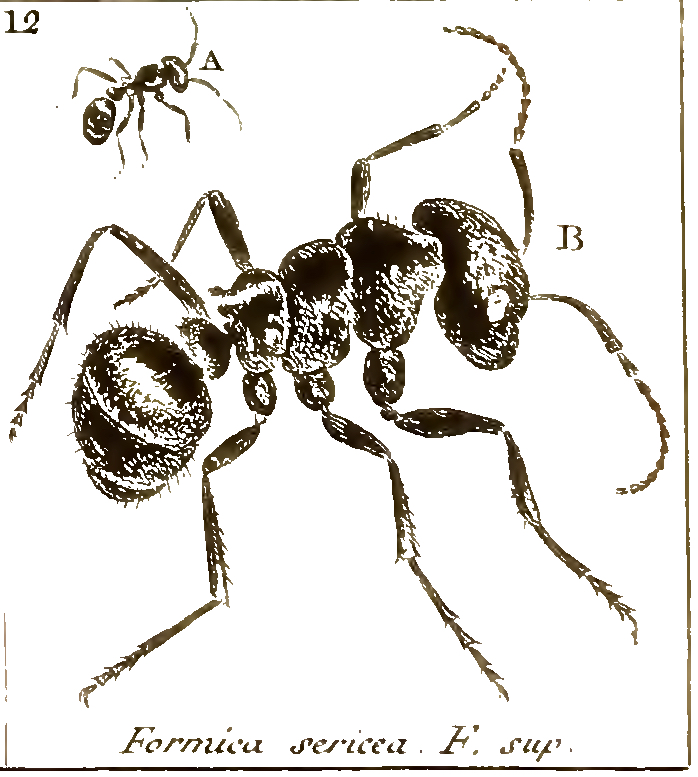 Fabricius' (1798) description is at Fabricius' (1798) description is at  , illustration by Coquebert (1804 pt 3) type in the Paris Museum. Latreille's (1802c)
description of the queen, as aurulenta, is at , illustration by Coquebert (1804 pt 3) type in the Paris Museum. Latreille's (1802c)
description of the queen, as aurulenta, is at  . Lepeletier de
Saint-Fargeau (1835: 213) gave a description, this is at . Lepeletier de
Saint-Fargeau (1835: 213) gave a description, this is at  . Mayr (1862: 675) gave a
description of the Egypt and eastern form, this is at . Mayr (1862: 675) gave a
description of the Egypt and eastern form, this is at  . Mayr's (1866b: 886) description of the
queen is at . Mayr's (1866b: 886) description of the
queen is at  . Forel's (1886f)
description of the male from Egypt is at . Forel's (1886f)
description of the male from Egypt is at  . Forel (1891b: 56)
provided a description and notes which seem to blanket both the sericeus
ss and obtusus forms, this is at . Forel (1891b: 56)
provided a description and notes which seem to blanket both the sericeus
ss and obtusus forms, this is at  . Arnold (1924: 709-710) provided a
description and notes, this is at . Arnold (1924: 709-710) provided a
description and notes, this is at  . .
Note - With fresh specimens, I have removed the
following Santschi (1926b) forms to Camponotus
obtusus - v obtusus Sm. - head red; alitrunk variable
black or red; legs brown; pubescence somewhat golden; petiole, scale
less thick at summit [from Egypt, Port Said by Karavaiev; from Obok, by
Maindron, 1893; and from Jansuame, Sahara, Iferouman Region, by Mission
Fourreau-Lamy, 1900)
and, Camponotus
euchrous (Camponotus (Orthonotomyrmex) sericeus F. v. euchrous
n. var., Santschi, 1926b: 267, queen) from French Sudan
[western Sahel; not modern Sudan, as given by Bolton, 1995] -
head, alitrunk and appendages red often quite bright; more slender;
petiole scale higher; gaster black; pubescence greyish yellow.
|
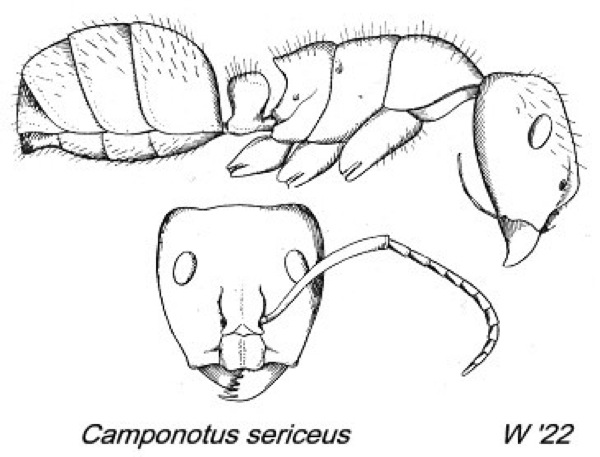 Emery
(1895k) noted peguensis
(photomontage below) from the form of the alitrunk as close to C. opaciventris Mayr, longer than
the true sericeus; the whole
body clothed with ashy pubescence, denser and shiner on the gaster; the
erect hairs more numerous than the type form; the scape and legs with
numerous short whitish hairs. Colour black, with the mandible,
antennae and legs dull ferruginous brown; otherwise with no important
characters. From comparing the sulgeri
type minor and the peguensis minor (for that
it is what it seems to be) it is obvious that peguensis is a very distinct species. Camponotus peguensis (C.
sericeus Fab., subsp. peguensis
n. subsp., Emery, 1895k:
479, minor worker) Myanmar (Burma) - see http://www.antweb.org/specimenImages.do?code=casent0905412. Emery
(1895k) noted peguensis
(photomontage below) from the form of the alitrunk as close to C. opaciventris Mayr, longer than
the true sericeus; the whole
body clothed with ashy pubescence, denser and shiner on the gaster; the
erect hairs more numerous than the type form; the scape and legs with
numerous short whitish hairs. Colour black, with the mandible,
antennae and legs dull ferruginous brown; otherwise with no important
characters. From comparing the sulgeri
type minor and the peguensis minor (for that
it is what it seems to be) it is obvious that peguensis is a very distinct species. Camponotus peguensis (C.
sericeus Fab., subsp. peguensis
n. subsp., Emery, 1895k:
479, minor worker) Myanmar (Burma) - see http://www.antweb.org/specimenImages.do?code=casent0905412.
Santschi
(1913c) gave a very brief note on sulgeri
as smaller than the type and with sparser pubescence, also a somewhat
longer and more concave propodeum.
Santschi (1926b) had - the type is entirely black, the pelt of
pubescence is greyish yellow; the pelt is missing in var. sulgeri;
from Ivory Coast at Dimbroko by Lemoult, Dahomey, at Kouande by Desanti
(Benin) and Casmance by Claveau.
Wheeler (1922) included an illustration of a worker
(full profile and full-face head), showing it to be characterised by a
concave posterior face to the propodeal declivity and a cuboid petiole
(otherwise it resembles Camponotus vividus). He listed findings
from Senegal (Dakar, C. Alluaud, F. Silvestri, and Cape
Verde), Togo (Misahöhe, by Smend), Nigeria (Moor
Plantation nr. Ibadan, W.A. Lamborn); elsewhere from widely across
sub-Saharan Africa.
Santschi (1929c) noted that it had been found by de
Peyerimhoff at Hoggar, Tamanrasset, Algeria, i.e. in the centre
of the Sahara Desert, 6 to 10.iii.1928, 4 minor workers.
Its use of chemical signals in recruitment for
tandem-running was studied by Hölldobler and colleagues (see Bradshaw
& Howse, 1984).
Listed as a savannah species in Ivory Coast by
Lévieux & Louis (1975). Lévieux (1978, 1983a), noted its presence
(or a close relative) in savannah, at Ferkéssédougo, where it was
preyed on by Myrmicaria opaciventris (as nitidans).
|
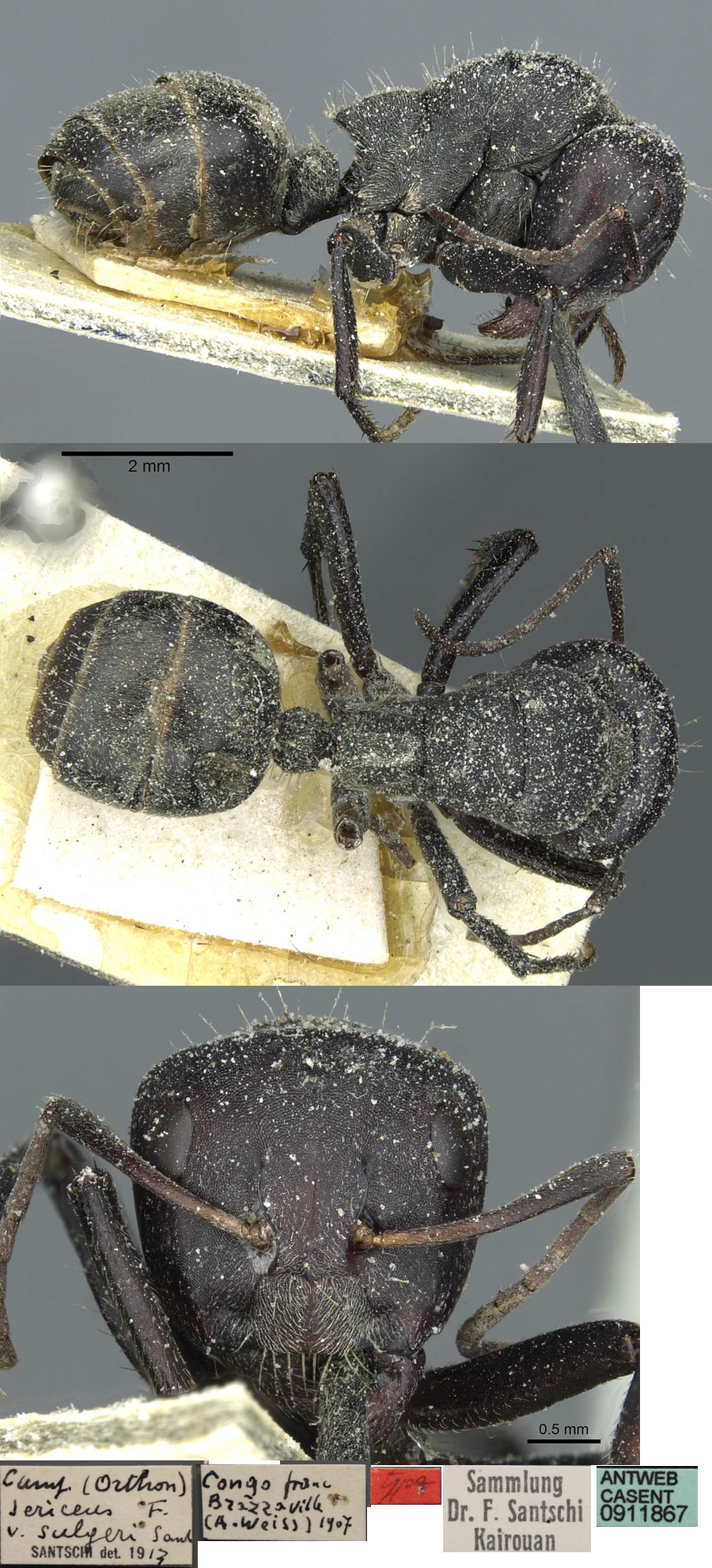 The photomontage of
the sulgeri type major is collated from http://www.antweb.org/specimen.do?name=casent0911867. The photomontage of
the sulgeri type major is collated from http://www.antweb.org/specimen.do?name=casent0911867.
|
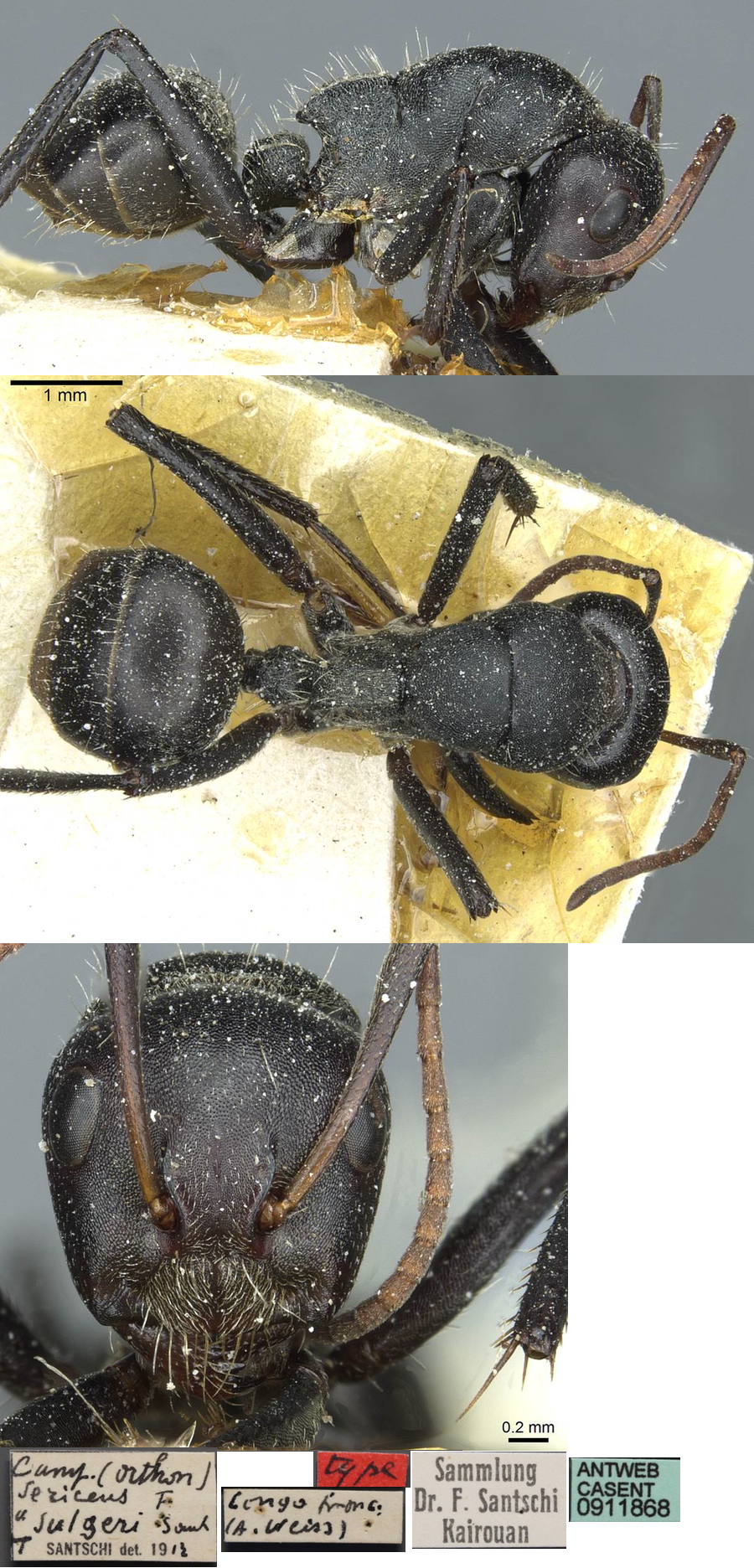 The photomontage of
the sulgeri type minor is collated from http://www.antweb.org/specimen.do?name=0911868. The photomontage of
the sulgeri type minor is collated from http://www.antweb.org/specimen.do?name=0911868.
|
Oxford University Museum
specimens
|
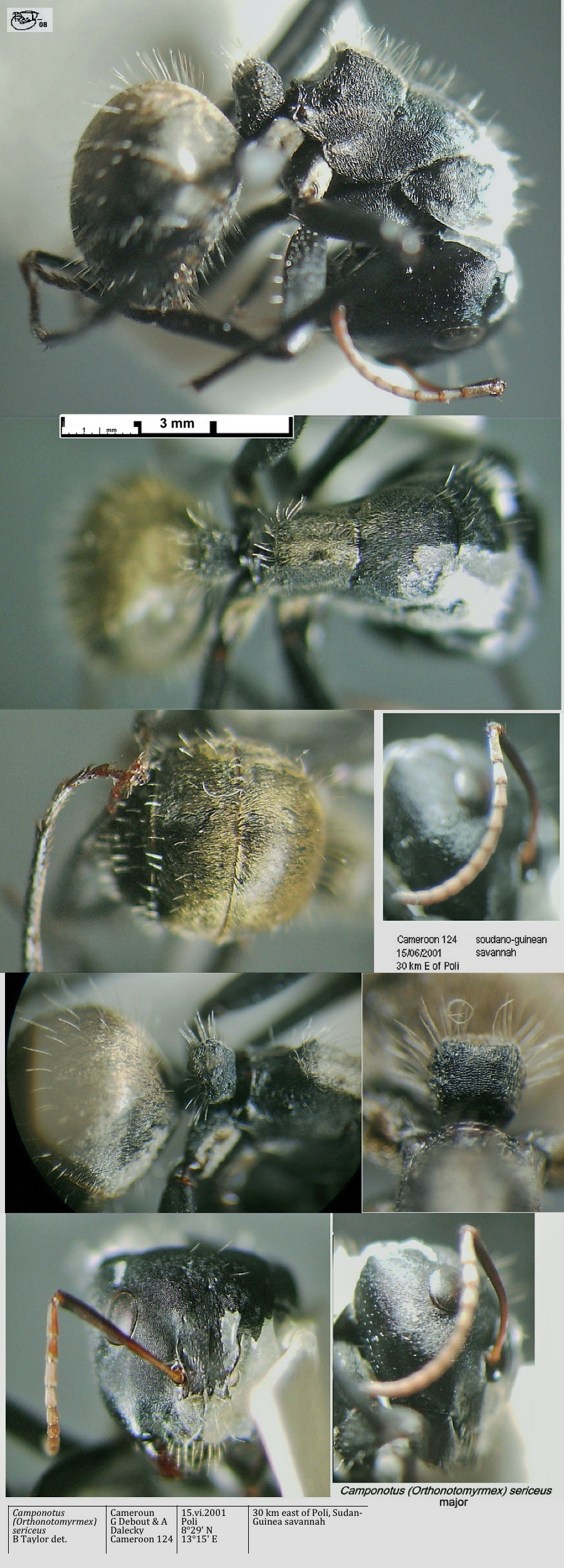 The photomontage is
of a major worker with a minor worker below,
collected in Cameroun - 30 km east of Poli (ca °29' N 13°29' E)
at a Sudan-Guinea savannah location (McKey Wolbachia project) -
Cameroon 124, 15 June 2001. The photomontage is
of a major worker with a minor worker below,
collected in Cameroun - 30 km east of Poli (ca °29' N 13°29' E)
at a Sudan-Guinea savannah location (McKey Wolbachia project) -
Cameroon 124, 15 June 2001.
|
 Photomontage of a
media worker from Burkina Faso,
collector
David King (King 93). Photomontage of a
media worker from Burkina Faso,
collector
David King (King 93).
|
 Minor worker from Cameroun
(details above). Minor worker from Cameroun
(details above).
|
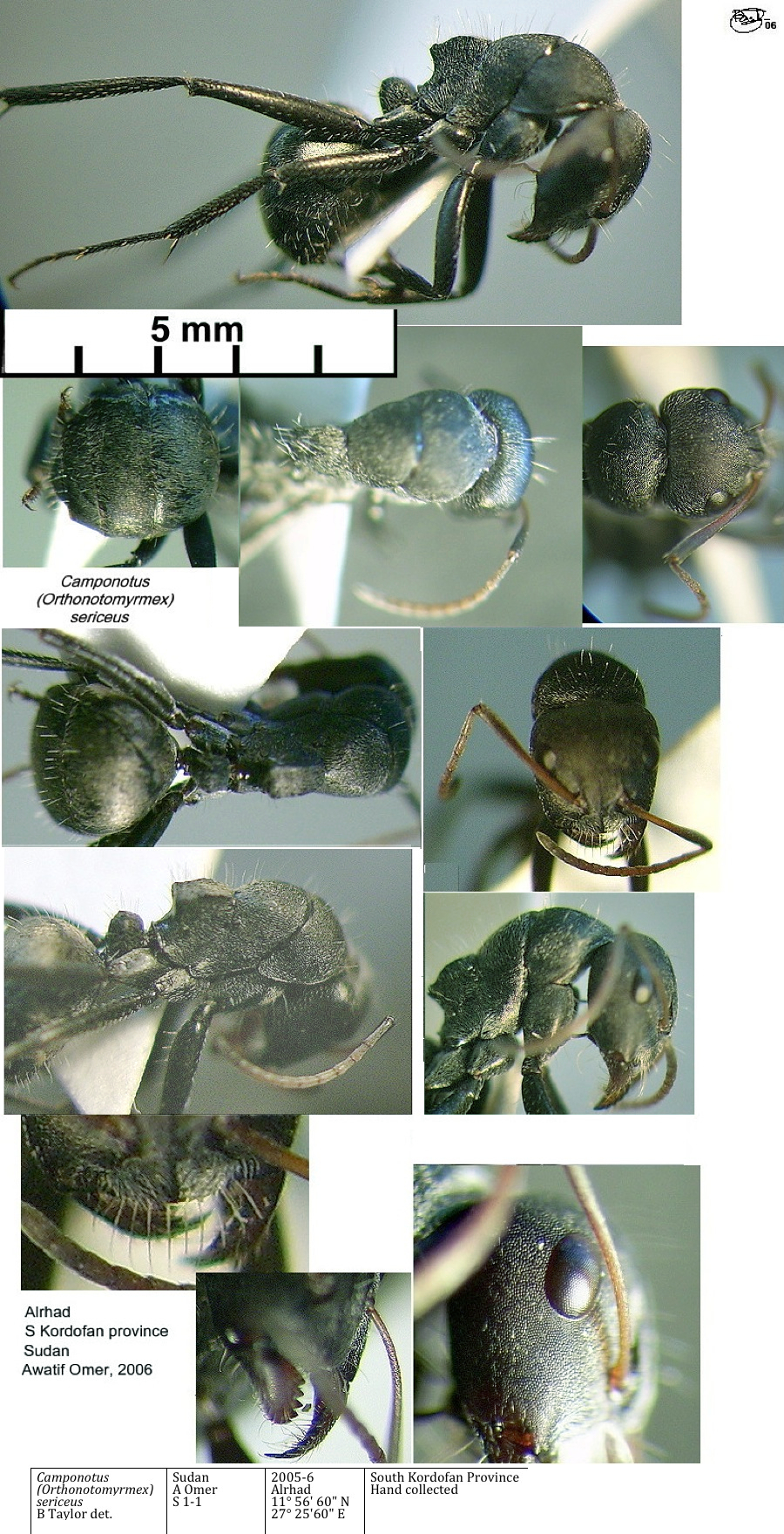 Photomontage
of minor workers from Sudan, collected by Awatif Omer. Photomontage
of minor workers from Sudan, collected by Awatif Omer.
|
|
Supplementary
Note
|
Camponotus (Orthonotomyrmex) sericeus
(Fabricius) -
status as in Bolton (1995: 123)
 Type location Senegal
(Formica sericea, in Fabricius, 1798: 279, worker; Mayr, 1866b:
886, queen; Forel, 1886f: 192, male; Forel, 1891b: 56, all forms);
subspecies euchrous (Santschi, 1926b: 267, queen) from French
Sudan [western Sahel; not modern Sudan, as given by
Bolton], opaciventris (Mayr, 1879: 648, worker; junior synonym
Bingham, 1903: 376; revived from synonymy as variety, Forel 1908a: 6,
cited in Emery, 1925b: 126) from India, peguensis
(Emery, 1895k: 479, worker) from Burma (also igniceps,
as var of peguensis, Forel, 1913e: 664, worker, from Sri
Lanka), and sanguiniceps (Donisthorpe, 1942d: 458, worker) from
South India, and sulgeri (Santschi, 1913c:
313,
worker) from Congo; Type location Senegal
(Formica sericea, in Fabricius, 1798: 279, worker; Mayr, 1866b:
886, queen; Forel, 1886f: 192, male; Forel, 1891b: 56, all forms);
subspecies euchrous (Santschi, 1926b: 267, queen) from French
Sudan [western Sahel; not modern Sudan, as given by
Bolton], opaciventris (Mayr, 1879: 648, worker; junior synonym
Bingham, 1903: 376; revived from synonymy as variety, Forel 1908a: 6,
cited in Emery, 1925b: 126) from India, peguensis
(Emery, 1895k: 479, worker) from Burma (also igniceps,
as var of peguensis, Forel, 1913e: 664, worker, from Sri
Lanka), and sanguiniceps (Donisthorpe, 1942d: 458, worker) from
South India, and sulgeri (Santschi, 1913c:
313,
worker) from Congo;
junior synonyms aurulenta (Latreille, 1802c: 114, illustrated,
queen) from Senegal, obtusa (Smith, F., 1858b, worker)
from Egypt, and pyrrhocephala (Motschoulsky, 1863: 11,
worker) from Sri Lanka; all forms known.
|
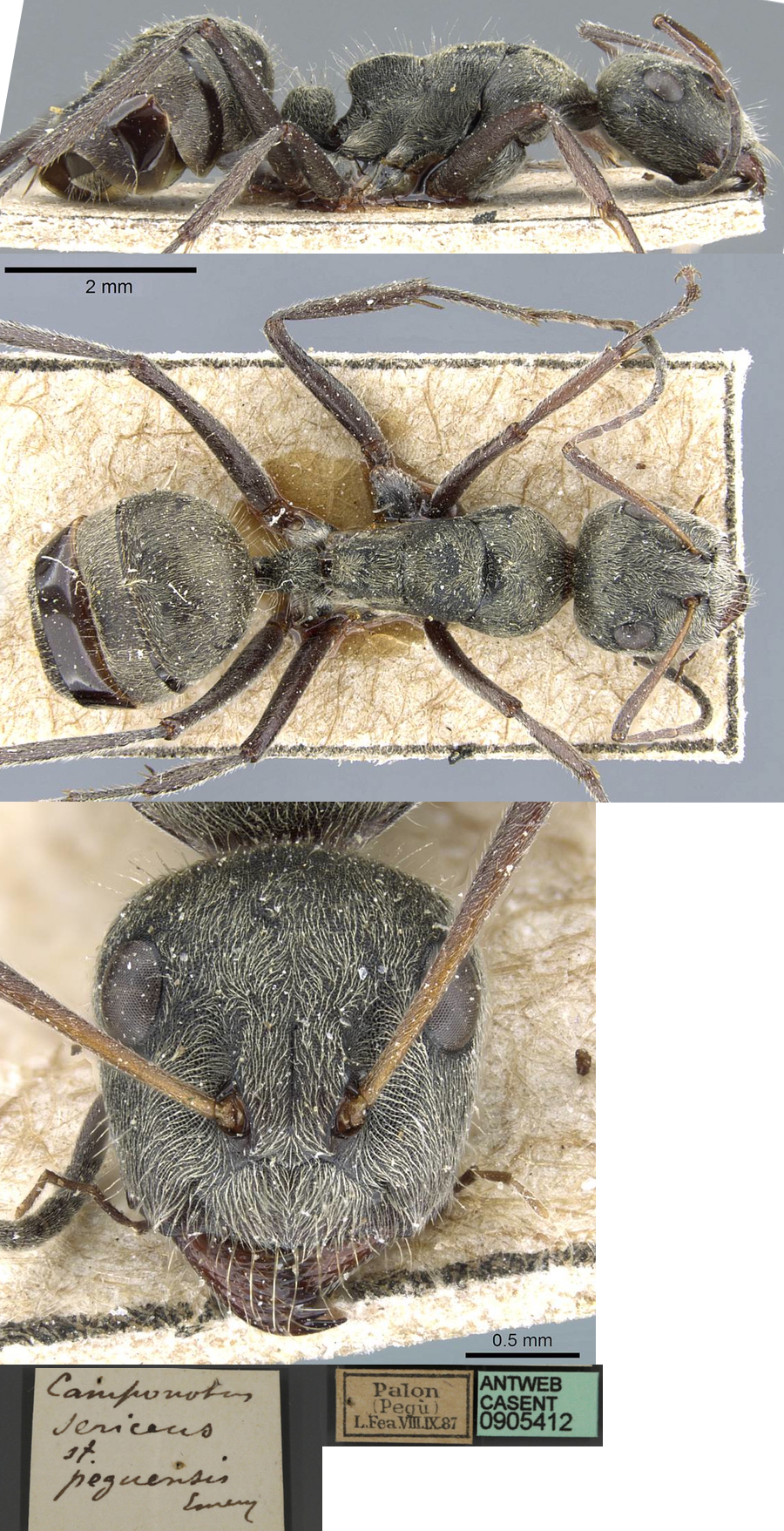 The
photomontage of a
type series minor worker of peguensis
from Myanmar (Burma) is collated from http://www.antweb.org/specimen.do?name=casent0010986. The
photomontage of a
type series minor worker of peguensis
from Myanmar (Burma) is collated from http://www.antweb.org/specimen.do?name=casent0010986.
|
|